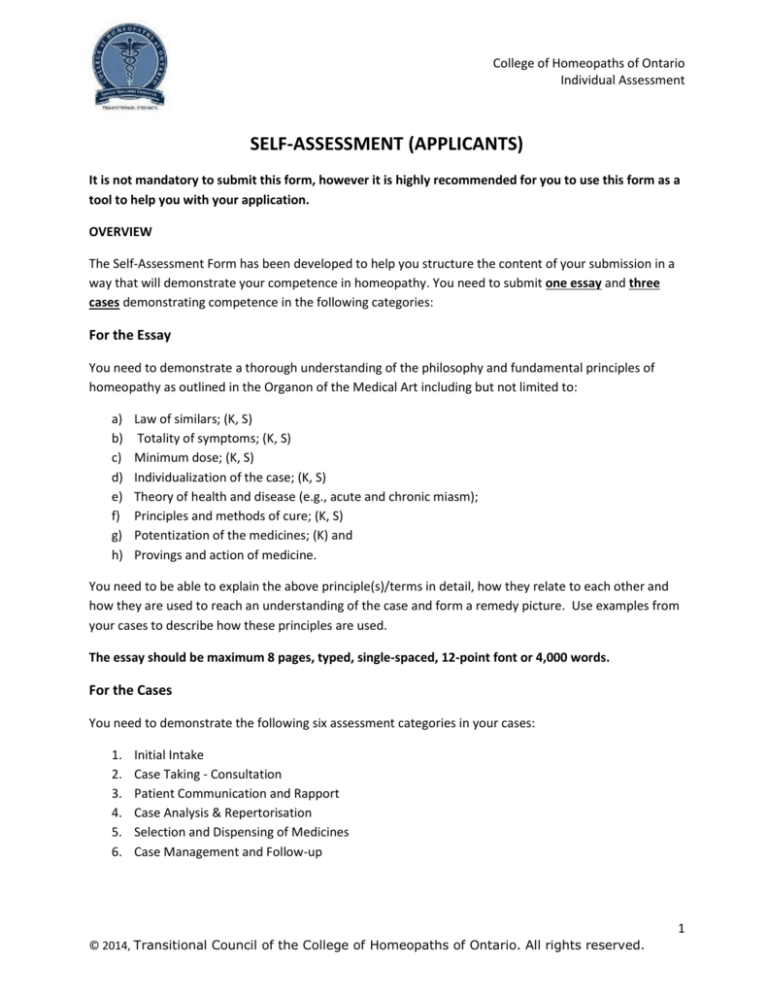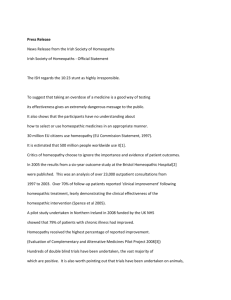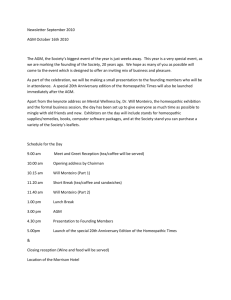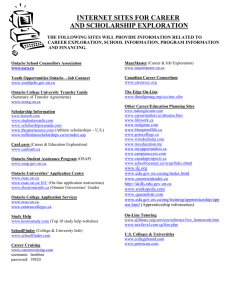
College of Homeopaths of Ontario
Individual Assessment
SELF-ASSESSMENT (APPLICANTS)
It is not mandatory to submit this form, however it is highly recommended for you to use this form as a
tool to help you with your application.
OVERVIEW
The Self-Assessment Form has been developed to help you structure the content of your submission in a
way that will demonstrate your competence in homeopathy. You need to submit one essay and three
cases demonstrating competence in the following categories:
For the Essay
You need to demonstrate a thorough understanding of the philosophy and fundamental principles of
homeopathy as outlined in the Organon of the Medical Art including but not limited to:
a)
b)
c)
d)
e)
f)
g)
h)
Law of similars; (K, S)
Totality of symptoms; (K, S)
Minimum dose; (K, S)
Individualization of the case; (K, S)
Theory of health and disease (e.g., acute and chronic miasm);
Principles and methods of cure; (K, S)
Potentization of the medicines; (K) and
Provings and action of medicine.
You need to be able to explain the above principle(s)/terms in detail, how they relate to each other and
how they are used to reach an understanding of the case and form a remedy picture. Use examples from
your cases to describe how these principles are used.
The essay should be maximum 8 pages, typed, single-spaced, 12-point font or 4,000 words.
For the Cases
You need to demonstrate the following six assessment categories in your cases:
1.
2.
3.
4.
5.
6.
Initial Intake
Case Taking - Consultation
Patient Communication and Rapport
Case Analysis & Repertorisation
Selection and Dispensing of Medicines
Case Management and Follow-up
1
© 2014, Transitional Council of the College of Homeopaths of Ontario. All rights reserved.
College of Homeopaths of Ontario
Individual Assessment
The Competency Profile for Entry‐to‐Practice Homeopaths Practising in Ontario serves as the underlying
foundation of how the six case-based categories need to be demonstrated. The competencies support the
six assessment categories as follows:
Category
Competencies
1.
2.
3.
4.
5.
6.
2.25, 2.26
2.28
2.30
2.33, 2.8, 2.9, 2.19, 2.35, 2.6, 2.34, 2.32, 2.21, 2.36
2.37, 2.38, 2.39, 2.40
2.43, 2.46
Initial Intake
Case Taking - Consultation
Patient Communication and Rapport
Case Analysis & Repertorisation
Selection and Dispensing of Medicines
Case Management and Follow-up
As a rule, the total length of cases submitted should be a maximum of 25 pages, typed, single-spaced, 12point font, or 12,500 words.
To be eligible to apply for Grandparented Registration Class, you must demonstrate ALL six (6) of the
case categories at least two times throughout your cases.
To be eligible to apply for Full Registration Class, you must demonstrate ALL six (6) of the case categories
at least two times throughout your cases and demonstrate all the Homeopathy Principles through the
essay.
As a rule, your application should be a maximum 33 pages, typed, single-spaced, 12-point font or
16,500 words.
The next page has guidelines on how to demonstrate the above competencies in your cases. Keep track of
which competencies you have demonstrated and in which case in the three columns on the right.
2
© 2014, Transitional Council of the College of Homeopaths of Ontario. All rights reserved.
College of Homeopaths of Ontario
Individual Assessment
1. Initial Intake
Demonstrated
in case #1, 2, 3
This section has two parts. The first is addressed by providing evidence that you
have obtained informed consent (see TC-CHO policy on informed consent) and
explaining the purpose of the homeopathic consultation, treatment expectations
and fee structure to the patient.
Provide a sample Consent Form (see TC-CHO standard no. 10 “Informed Consent”).
The competency assessed in this section is:
1)
2.25 Inform the patient and obtain informed consent regarding the nature of
the homeopathic process including:
a) Confidentiality; (K, S)
b) Basic homeopathic principles and process;
c) Nature and safety of medicine;
d) Duration and frequency of visits;
e) Treatment expectations (acute vs. chronic, prognosis); and
f) Fee schedule.
The second part is addressed by providing a sample of a patient intake form and
clearly explaining the information in the patient intake form in your cases.
The competency assessed in this section is:
2)
2.26 Review patient intake form (e.g., family health history, patient health
history, chief complaint, etiology, supplements and pharmaceuticals, lifestyle
assessment).
3
© 2014, Transitional Council of the College of Homeopaths of Ontario. All rights reserved.
College of Homeopaths of Ontario
Individual Assessment
2. Case Taking - Consultation
Demonstrated
in case #1, 2, 3
This section is addressed by documenting detailed information regarding the health
status of the patient and explaining your thought process to obtain a totality of
symptoms.
The competency assessed in this section is:
1)
2.28 Collect detailed information regarding the health status of the patient to
obtain a totality of symptoms using the following:
Subjective findings including:
a) Patient’s personal account of chief complaints and other symptoms (e.g.,
health/illness/experiences and the effects on quality of life); (K, S) and
b) Information provided by the patient’s extended network if appropriate
(e.g., family, caregiver).
Objective data including:
c) Homeopath’s observation (i.e., visual, etc.) (K, S)
d) Physical exam, as required, within the scope of practice of homeopathy;
(K, S) and
e) Medical tests, diagnostic or laboratory result reports.
Address by:
(i) Providing detailed information about the patient’s chief complaints and other
symptoms.
(ii) Providing information from the patient’s extended network, if appropriate.
(iii) Providing detailed information about observations of the patient, such as
patient’s non-verbal communication, gestures, etc.
(iv) Describing conditions when a physical exam may be necessary. When
conducting a physical exam demonstrate any of the following: observation,
palpation, percussion, auscultation. Document your observations and clinical
data from the physical exam, as may be appropriate.
(v) Including the use of medical tests, as appropriate. Document conclusions
obtained from any medical tests and diagnostic or laboratory reports.
4
© 2014, Transitional Council of the College of Homeopaths of Ontario. All rights reserved.
College of Homeopaths of Ontario
Individual Assessment
3. Patient Communication and Rapport
Demonstrated
in case #1, 2, 3
This section is addressed by describing how you would adapt your listening skills to
take into account the patient’s unique needs. To do this, you should structure your
cases, at least partially, in a question-and-answer format to demonstrate reciprocal
communication.
The competency assessed in this section is:
1)
2.30 Demonstrate interviewing and case‐taking skills to elicit spontaneous
responses from the patient (e.g., using open‐ended questions, avoiding
leading questions, respecting silence). (K)
4. Case Analysis
Demonstrated
in case #1, 2, 3
This section covers the bulk of your thought process required to do case analysis.
Below is a list of the competencies assessed in the Case Analysis section with
instructions on how to address them in your cases.
1)
2.33 Use various approaches to case analysis (e.g., etiology, totality of
characteristic symptoms, constitutional basis.
Address by explaining the thought process in your case analysis and how
you arrived at your homeopathic diagnosis. Provide a homeopathic
differential analysis.
2)
3)
2.8 Understand how the psychological and emotional states of the individual
can affect the patient’s health and well‐being. (K, S)
Address by describing the importance of Mind (Mental) symptoms in
remedy selection.
2.9 Identify potential obstacles to cure including, but not limited to,
nutritional imbalances, environmental imbalances, and environmental
exposure and toxicity. (K)
Address by explaining the exciting/maintaining causes and/or common
obstacles to cure.
4)
2.19 Recognize common symptoms of pathologies in order to identify
characteristic and individualized symptoms in the patient. (K,S)
Address by differentiating between common and uncommon symptoms /
provide identification of characteristic and individualized symptoms (i.e.,
strange, rare and peculiar symptoms).
5
© 2014, Transitional Council of the College of Homeopaths of Ontario. All rights reserved.
College of Homeopaths of Ontario
Individual Assessment
4. Case Analysis
5)
Demonstrated
in case #1, 2, 3
2.35 Research homeopathic references and literature to confirm the
medicine selection using:
a) Materia Medica;
b) Clinical and proving data;
c) Historical journals; and
d) Cured cases.
Address by referencing the use of Materia Medica to support your remedy
selection.
6)
2.6 Demonstrate a thorough knowledge of the process of repertorization
including:
a) The structure, organization, advantages and limitations of Repertory;
b) Defining rubrics by translating patient narrative into the condensed
language of the homeopathic Repertory;
c) Grading of the symptoms and the remedies and their significance; and
d) Technique of repertorization.
Address by demonstrating repertorization.
7)
2.34 Select rubrics for repertorization to reach a homeopathic differential
diagnosis.
Address by describing how you would select the relevant rubrics and
develop a short list of rubrics.
8)
2.32 Analyze case findings to identify the characteristic signs and symptoms
to construct a hierarchy of symptoms (e.g., “image of the disease”).
Address by arranging the characteristic symptoms that you have identified
within your case to reflect the totality of symptoms.
9)
2.21 Recognize when homeopathic treatment can complement, interact
and/or interfere with other health care that the patient is receiving.
Address by illustrating where homeopathic treatment has either
complemented, interacted with, or interfered with other health care
treatment.
10)
2.36 Synthesize the collected information and utilize critical thinking to arrive
at a homeopathic diagnosis. (K)
Address by explaining why you chose the remedy for your patient.
6
© 2014, Transitional Council of the College of Homeopaths of Ontario. All rights reserved.
College of Homeopaths of Ontario
Individual Assessment
5. Selection and Dispensing of Medicines
Demonstrated
in case #1, 2, 3
This section covers the selection and dispensing of medicines. Below is a list of the
competencies assessed in the Selection and Dispensing of Medicines section with
instructions on how to address them in your cases.
1)
2.37 Select suitable medicine or sequence of medicines to restore/maintain
optimal health and vitality. (K, S)
Address by describing which medicine(s) would create a curative effect.
Include a differential diagnosis.
Describe any subsequent medicines that you have used following your
original remedy choice and explain why you have used them.
2)
2.38 Select administration of medicine including:
a) Homeopathic potency (e.g., MT, X, D, C, Q or LM). (K);
b) Posology (e.g., dosage). (K);
c) Delivery mechanism (e.g., dry, liquid, injectable when or if approved in
the scope of practice). (K)
Address by describing the thought process behind selecting the
homeopathic potency, posology and delivery mechanism.
3)
2.39 Provide written instruction to patient on use of medicine including:
a) Administration; (K, S)
b) Storage; (K, S)
c) Cautions and warnings; (S)
d) Interactions; (K,S) and
e) Dietary and lifestyle recommendations. (K, S)
Address by providing, in writing, administration, storage, cautions and
warning, interactions, and recommended dietary and lifestyle changes,
where applicable.
4)
2.40 Communicate individualized treatment plan to the patient.
Address by confirming with the patient that he/she understands the
treatment plan.
7
© 2014, Transitional Council of the College of Homeopaths of Ontario. All rights reserved.
College of Homeopaths of Ontario
Individual Assessment
6. Case Management and Follow-up
Demonstrated
in case #1, 2, 3
This section covers case management and follow-up. Below is a list of the
competencies assessed in the Case Management and Follow-up section with
instructions on how to address them in your cases.
1)
2)
2.43 Evaluate, interpret and adjust treatment plan (e.g., second prescription)
taking into consideration direction of cure, return of old symptoms, and/or
new symptomatology. (S)
Address by recording, as part of follow-up, the patient’s observations after
administration of the homeopathic medicine. Recognize the impact of the
previous treatment and identify when there is a need to change the
treatment plan.
2.46 Recommend referral and/or collaborate with other health‐care
practitioners, as required, to provide optimal care to the patient. (S)
Address by including a case where a referral to another health-care provider
is made, as may be required by the circumstances of the case.
8
© 2014, Transitional Council of the College of Homeopaths of Ontario. All rights reserved.





